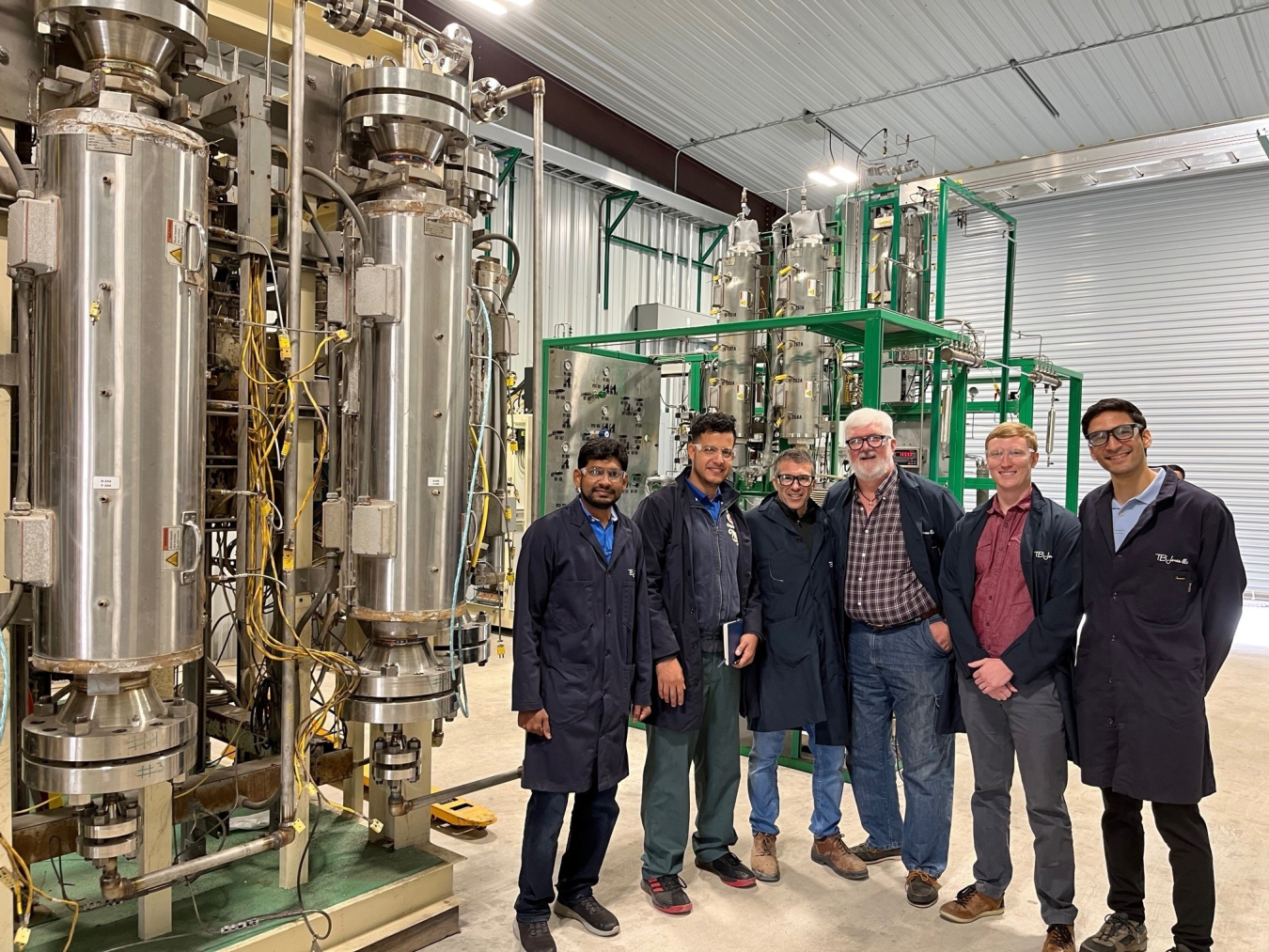Startup firm Pyran recently took a huge leap forward in the development of its technology to make renewable industrial chemicals, achieving an extraordinary 1,000-times scaleup of its reactor in a single step.
December 9, 2022
Author: Tim Theiss, Laboratory Relationship Manager, Oak Ridge National Laboratory
Read Tim's bio ►
Meet the other bloggers ►
Return to Bioprose blog ►

Scientists from ORNL, Pyran, and RPD Technologies pose in front of the pilot-scale reactor testbed. Photo courtesy of ORNL.
Startup firm Pyran recently took a huge leap forward in the development of its technology to make renewable industrial chemicals, achieving an extraordinary 1,000-times scaleup of its reactor in a single step. The achievement was made possible with computational modeling and simulation provided by the U.S. Department of Energy’s (DOE) Oak Ridge National Laboratory (ORNL).
Bridging the gap between breakthroughs in the lab and commercial-scale operation is critical to the establishment of biorefineries that can replace the production of fossil fuel-based petrochemicals and help decarbonize the U.S. economy.
In this case, Madison, Wisconsin-based Pyran received help through the Consortium for Computational Physics and Chemistry, or CCPC, led by ORNL for the DOE Office of Energy Efficiency and Renewable Energy’s Bioenergy Technologies Office (BETO). The consortium leverages modeling and simulation capabilities at the national labs to help bioenergy companies resolve technical roadblocks to deployment.
The program paired Pyran with modelers in the Chemical Process Scale-Up Group at ORNL to suggest improvements to critical steps in Pyran’s process creating biomass-based 1,5-pentanediol, a specialty chemical used to make paints, adhesives, and other products.
Grams to Kilos
ORNL scientists took data from the lab-scale reactor using approximately 60 grams of catalyst, analyzed all aspects of the process, and suggested modifications for scaleup. The resulting pilot-scale reactor used 62 kilograms of catalyst to create multi-ton quantities of the immediate precursor to pentanediol. The end-product will go to companies for testing in the manufacture of consumer goods.
“We achieved stable, reliable solutions at 1,000 times the lab reactor scale,” said Bruce Adkins, an ORNL senior scientist with broad experience in the private bioenergy sector. Adkins co-led the project with ORNL’s Canan Karakaya, whose expertise in complex thermodynamics helped resolve heat transfer and other issues. “In the industry, a scaleup of even 100 times is astonishing, and here we have achieved 10 times that much in a single step,” Adkins said.
“Being able to access this expertise at DOE is essential to bringing renewable chemicals to the market to achieve the nation’s climate goals,” said Kevin Barnett, Chief Technology Officer at Pyran. “The model that Bruce and Canan developed can be scaled even further to help us design a commercial-scale operation.”
Beakers to Business
“Scaling up is not just a question of sizing up,” Adkins noted. “It’s how the design and configuration need to change, and typically it doesn’t look anything like the lab-size reactor you started with.” Adkins also put Pyran in touch with a testbed company, RPD Technologies of Houston, where the pilot-scale reactor design was set up, run, and analyzed. ORNL worked with Pyran to develop operational procedures for the RPD Technology reactor and will help develop a deactivation model as well.
“Running these data-fed simulations helps industry achieve their goals much faster and at less expense,” Adkins said. “This is the kind of thing I dreamed of being able to do when I worked in industry."
CCPC is one of nine BETO bioenergy consortia using the capabilities of the DOE national laboratory system to overcome the challenges of researching and developing competitive, cost-effective, and scalable fuels and products made from renewable biomass.
UT-Battelle manages ORNL for the Department of Energy’s Office of Science, the single largest supporter of basic research in the physical sciences in the United States. The Office of Science is working to address some of the most pressing energy challenges of our time. For more information, please visit the Office of Science website.
Tim Theiss

Tim has been on the staff at Oak Ridge National Laboratory (ORNL) since 1987 as a research development staff member, a program manager, and a group leader. He has over 20 years of experience in program development and program management at ORNL in various technical areas, primarily related to bioenergy and biofuels, power systems, and reciprocating engine-based power generation.
Since October 2011, Tim has been serving as the laboratory relationship manager or program manager for the U.S. Department of Energy (DOE) Office of Energy Efficiency and Renewable Energy’s Bioenergy Technologies Office. This applied bioenergy program includes research on feedstock supply and logistics, biomass conversion technologies, and the strategic analysis and sustainability of bioenergy.
From 2008 to 2012, Tim led ORNL’s Fuels and Engines Research Group, one of the larger comprehensive internal combustion engine research and development groups in the DOE system. He has a master’s degree in engineering mechanics from Virginia Tech and a bachelor’s degree in engineering science and mechanics from Tennessee Tech.
Meet our other bloggers ►
Return to Bioprose blog ►

